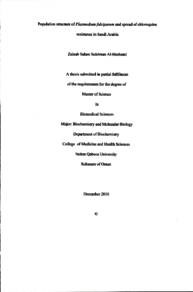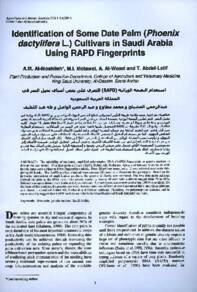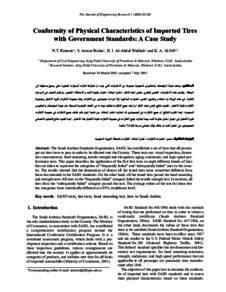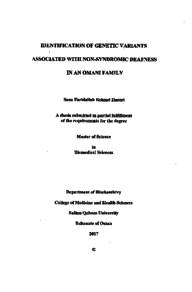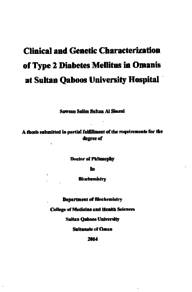Document
Population structure of plasmodium falciparum and spread of chloroquine resistance in Saudi Arabia
Publisher
Sultan Qaboos University
Gregorian
2010
Language
English
Subject
English abstract
Aim and rational: Malaria is one of the most fatal diseases caused by parasite of the genus Plasmodium, where P. falciparum causes the most severe and lethal malaria. Malaria is widely distributed in the tropical and subtropical zones, and most cases are reported in sub-Saharan Africa. The Arabian Peninsula is at the fringes of malaria endemicity, where control efforts have brought local transmission to halt in many parts. However, with prevalent some areas in Yemen and south-west Saudi Arabia, parasites remain malarious drug resistant.
The overall aims of this project are to examine the source of chloroquine resistance (CQR) and investigate the genetic structure of P. falciparum in Jizan region in Saudi Arabia. Alleles of pfcri (chloroquine resistance transporter) and Pfmdrl (multidrug resistance I) genes were examined by polymerase chain reaction (PCR) and sequencing. In addition, microsatellites flanking both genes as well as neutral marker, P/9377 (not involved in drug response) were analysed. Thus, haplotypes composed of pfcri and Pfmdrl genes and close flanking microsatellites were constructed and compared to those seen in other endemic countries.
Results: 162 (99%) out of 164 examined P. falciparum isolates harboured the triple mutant genotypes (C72 V73 174 E7 T) which exist in many countries in Africa and South East Asia. Out of 165 Pfmdrl isolates, 109 (66%) and 51 (31%) isolates harboured single (N86 L87 F154 W186 S1034 N1042) and double mutant genotype (Y3687 F14 W 186 S1034 N1042), respectively. In addition, three new SNPs were detected, two synonymous (182[3] and 102[3]) and one non- synonymous (19212]). In the present study, 15 Pfert haplotypes with distinct microsatellites background were detected in Jizan, 13 were associated with the triple mutant CVIET, which is the common COR-associated Pfert allele in many part of Southeast Asia and Africa. Similarly, 60 Pfmdr/ haplotypes were detected, 3 were associated with the wild type allele, NYSN. However, 42 and 15 haplotypes carried single (NFSN) and double mutations (YFSN), respectively. All single mutant haplotypes existed at low prevalence, however, haplotype 54 with double Pfmdrl mutation existed at high frequency High diversity was seen in the neutral gene, Pfg377, (He=0.64) at least 5 alleles were detected among parasites in Jizan. However, sharp reduction in genetic diversity (He) of flanking loci was detected around double Pfmdr/ mutant (He 0.3) allele compared to single Pfmdrl mutant (He=0.76). Significant differentiation, Fr. (P-value < 0.0001) in allele frequency of flanking microsatellites was seen between parasites with single and double mutations. Moreover, significant LD between loci flanking Pfcrt and Pfmdrl genes was observed. There was low parasite multiplicity (13%), more than one genotype among infected people. Estimated mcan number of clones (1.23) used to estimate the in-breeding coefficient (0.879) which was high. Therefore, low recombination rate and clonal population structure of P. falciparum in Jizan area can lead to high LD and persistence of multi-drug resistant parasite.
Conclusion: This is the first study to examine the genetic structure of P. falciparum parasite and how COR evolved in Jizan region in Saudi Arabia. Such information will contribute to the development of better strategies to control spread of drug resistance in the region.
Member of
Resource URL
Category
Theses and Dissertations

